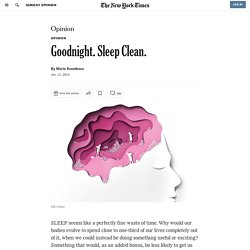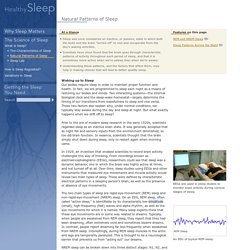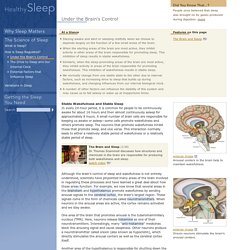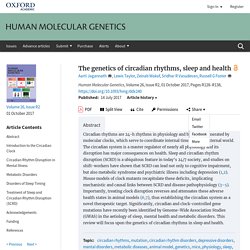

Goodnight. Sleep Clean. In a society that is not only chronically sleep-deprived but also rapidly aging, that’s bad news.

“It’s unlikely that poor sleep as a child would actually cause Alzheimer’s or Parkinson’s,” says Dr. Veasey, “but it’s more likely that you may shift one of those diseases by a decade or so. That has profound health and economic implications.” It’s a pernicious cycle. We work longer hours, become more stressed, sleep less, impair our brain’s ability to clean up after all that hard work, and become even less able to sleep soundly.
There is, however, reason to hope. “Such a test could also be used in the emergency room after traumatic brain injury,” Dr. We can also focus on developing earlier, more effective interventions to prevent cognitive decline. A second approach would take the opposite tack, by seeking to mimic the cleanup-promoting actions of sleep in the awake brain, which could make a full night of sound sleep less necessary. Sleep Drives Metabolite Clearance from the Adult Brain. Adverse Impact of Sleep Restriction and Circadian Misalignment on Autonomic Function in Healthy Young Adults. Natural Patterns of Sleep. Waking up to Sleep Our bodies require sleep in order to maintain proper function and health.

In fact, we are programmed to sleep each night as a means of restoring our bodies and minds. Two interacting systems—the internal biological clock and the sleep-wake homeostat—largely determine the timing of our transitions from wakefulness to sleep and vice versa. These two factors also explain why, under normal conditions, we typically stay awake during the day and sleep at night. External Factors that Influence Sleep.
Sleep in the Real World The internal mechanisms that regulate our almost ceaseless cycles of sleep and wakefulness make up a remarkable system.

However, a variety of internal and external factors can dramatically influence the balance of this sleep-wake system. Changes in the structure and function of the brain during development can have profound, if gradual, effects on sleep patterns. The amount of sleep we obtain generally decreases and becomes more fragmented throughout our lifespan. These and other variations associated with age are covered at length in the essay Changes in Sleep with Age. Other factors that affect sleep include stress and many medical conditions, especially those that cause chronic pain or other discomfort.
Light's Effect. The Drive to Sleep and Our Internal Clock. Sleep Drive Nodding off at an inopportune moment can be embarrassing or even dangerous.

And anyone who has experienced even a short bout of insomnia can attest to the frustration caused by the inability to sleep at a desired hour. Finding Your Sleep/Wake Rhythm. Under the Brain's Control. Stable Wakefulness and Stable Sleep In every 24-hour period, it is common for people to be continuously awake for about 16 hours and then almost continuously asleep for approximately 8 hours.

A small number of brain cells are responsible for keeping us awake or asleep—some cells promote wakefulness and others promote sleep. The neurons that promote wakefulness inhibit those that promote sleep, and vice versa. This interaction normally leads to either a relatively stable period of wakefulness or a relatively stable period of sleep. Although the brain's control of sleep and wakefulness is not entirely understood, scientists have pinpointed many areas of the brain involved in regulating these processes and have learned a great deal about how these areas function. One area of the brain that promotes arousal is the tuberomammillary nucleus (TMN). Another area of the hypothalamus is responsible for shutting down the brain’s arousal signals and causing the transition to sleep.
The Drive to Sleep and Our Internal Clock. Genetics of circadian rhythms, sleep and health. Skip to Main Content Advertisement Search Close Advanced Search.

Guidelines to Dream Interpretation. How do you relate to dreams?

A framework for dreams Painting by Bob Venosa All dreams work to accomplish one of two things: 1 To solve the problems of your conscious, waking life. 2 To present you with access to new potentials and creativity. 3 Symbols express those things for which we have no words. A dream symbol could literally represent itself as well as its possible interpretations. Dreams do not come to tell you what you already know. How do you relate to the dream? 1 Start by looking at how the dream could be reflecting something going on in your daily life. 2 Then move on to the more subtle, free association with the dream images. 3 Whats the first thing you would normally think about in connection to that symbol or image, activity or person appearing in your dream scenario?
Why do we sleep? - Nature Neuroscience. Nature Neuroscience 3, 1225 (2000) doi:10.1038/81735 Although there is still no satisfying answer to the question of why we sleep, rapid progress in the last several years suggests that this may soon change.

Perhaps a better understanding of the function of sleep will also help to change attitudes about sleep at a societal level. The average person requires about eight hours of sleep per night, but many otherwise healthy people continually deprive themselves of adequate sleep with consequences that include fatigue, poor decision-making and increased risk of accidents. New research, including two papers in this issue demonstrating that sleep is required for memory consolidation (p. 1237 and 1335; see also p. 1235), may convince people to take sleep more seriously.
A recent poll taken by the US National Sleep Foundation illustrates the extent of the problem. Accidents aside, one likely consequence of sleep deprivation is memory impairment. Dave, A.
Find Sleep Help & Resources for your Sleep Problems. Disruption in Health Care (and Sleep Medicine): “It’s the End of the World as We Know it…and I Feel Fine.” Biorhythms. CAM bam ma'am. Macro Health. MEDICO. PHILOs. Thinkingit. YogiGuru. Healthy Patterns. To Sleep To Dream.